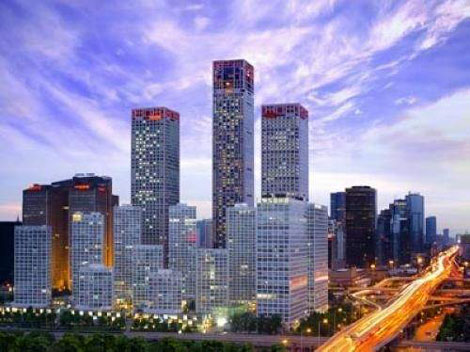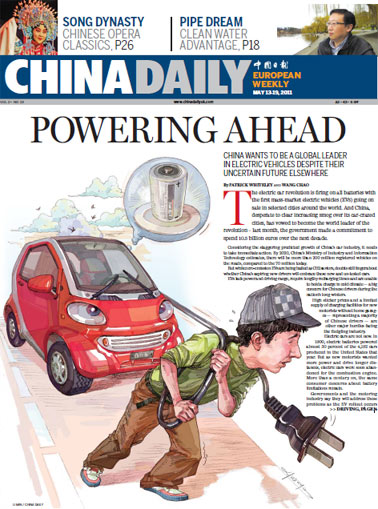People
Building communities
Updated: 2011-05-11 08:19
By Yu Tianyu (China Daily)
|
 Over the past 20 years, American architect John Portman and his company have developed more than 30 projects across China. Zhang Wei / China Daily |
|
 The Yintai Center in Beijing's CBD, designed and built by John Portman and his company. |
The architect's forays into China began in the 1980s when he designed the nation's first multifunctional real estate property, Shanghai Center. Yu Tianyu reports.
The ice-breaking visit of Deng Xiaoping to the United States in 1979 also marked a milestone in the life of a budding American architect. During his trip, the Chinese leader spent one night at Atlanta's Peachtree Center, one of the world's tallest buildings at that time.
Deng said: "China may not need such skyscrapers, but we do need buildings that pay so much attention to people's needs."
The man behind the magnificent building is John Portman. Completed in 1961, it is one of his signature works.
The 1.76-million-square-meter multi-block center is connected by a network of enclosed pedestrian sky bridges, allowing easy access to all its facilities.
Portman, 87, recalls vividly his meeting with Deng. "He came across as very sincere and obviously had plans to bring something to China," he says.
Later the same year, Portman was invited by Deng to China and he became one of the first group of foreign architects to leave their imprints on the landscape of a country that was just opening its doors to the world in the 1980s.
"There were bicycles everywhere and sometimes looked like a big torrential river flowing among buildings and streets, but very few cars," he says of his first trip in China.
In 1990, the nation's first multifunctional real estate project - the Shanghai Center - was completed by John Portman & Associates (JPA) and Portman Holdings.
"There were not many barriers and problems or even compromises because the Chinese then were keen to be part of the 21st century and anxious to move forward," Portman says.
Shanghai Center comprises three towers that rise dramatically from an eight-story podium, offering a five-star hotel, luxury apartments, office space, retail plaza and a trademark exhibition atrium.
While introducing Western-style concepts to China, the idea was also to build something supportive of Chinese culture.
The facade is cement colored to ensure it blends with the surroundings and is in keeping with the traditional architecture style of China's Anhui province.
"The trick is how do you preserve the old but good buildings and how do you add the new ones in a way that complement each other without being superficial," says Portman.
"I'm a humanist and design communities rather than just blocks or buildings," he stresses.
So far, Portman and his company have developed more than 30 projects across China including the Yintai Center in Beijing and Tomorrow Square in Shanghai, besides more than 120 projects around the world.
Located in the heart of Beijing's Central Business District and completed in 2008, Yintai Center has a 250-meter central tower crowned by a large cube with a built-in glass pyramid that resembles a Chinese lantern.
Another two towers of 186 meters stand on either side of the central tower and a podium, which connects the three towers that house top luxury boutiques, conference centers, a fitness center and an outdoor landscaped roof garden.
Portman says he believes a city should have a series of coordinates in which the size and design of buildings should be determined by how far people will walk before they start thinking of wheels.
"In modern times, we need to start creating neighborhoods that allow people to walk to the drugstore or grocery and the kids to walk to school," he says. "It is not only for the sake of the environment, but also for the quality of people's lives."
The best design is one that is holistic taking everything - from the environment to economics - into consideration, he adds.
Architecture is about time and can last thousands of years so architects need to be sensitive and not be carried away by the fads of the day, he says.
While technology may enable increasingly adventurous designs, it also makes people isolated. They are losing their sense of community, he notes.
"I like old Chinese structures like the Summer Palace which have a human touch," he says. "We are living in a mechanized world and this human touch is somehow missing."
The architect says he loves Beijing, especially Peking Roast Duck, despite the city's heavy traffic.
The John Portman Art & Architecture exhibition, showcasing his philosophy and works - of architecture, furniture, paintings and sculpture - over the past five decades, is now on at Capital Museum in Beijing and will run till June 12.
E-paper

War of the roses
European Chinese rose growers are beating their Chinese rivals at their own game
Preview of the coming issue
High-tech park gets big boost
At the source
Specials

New wave
Coastal city banks on marine sector to ride next stage of economic development

Drunk driving
Drunk drivers face a detention for one to six months and a revokation of their drivers' license.

V-Day parade
A military parade marking the 66th anniversary of the Soviet victory over Nazi.
